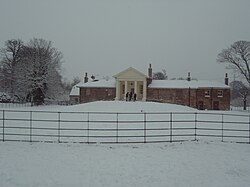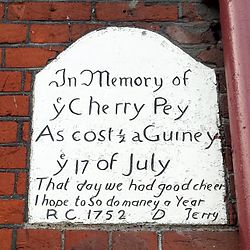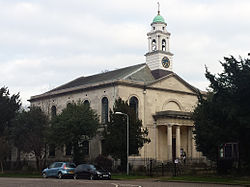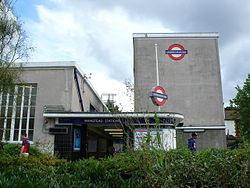Wanstead: Difference between revisions
No edit summary |
No edit summary |
||
| (2 intermediate revisions by one other user not shown) | |||
| Line 13: | Line 13: | ||
|constituency=Leyton and Wanstead | |constituency=Leyton and Wanstead | ||
}} | }} | ||
'''Wanstead''' is a town in | '''Wanstead''' is a town in south-western [[Essex]], within the greater London conurbation. It is contiguous with [[Leytonstone]] to the west, [[Snaresbrook]] to the north, [[Redbridge, Essex|Redbridge]] to the east and [[Forest Gate]] to the south. Wanstead is one of the greener towns in the area, containing the Wanstead Flats grasslands and the woodlands of Wanstead Park (part of [[Epping Forest]]), which was once home to a now demolished manor house. | ||
{{ | The place name is probably of Saxon origin and is first recorded in a charter of 1065 as Wenstede. The first element appears to mean 'wain' or 'wagon' but the meaning of the full compound is not clear. <ref>The Concise Oxford Dictionary of English Place Names, 4th edition. Eilert Ekwall 1990</ref> An alternative explanation by the English Place-Names Society is that the place name derives from the Anglo-Saxon words meaning ''Wen'', signifying a hill or mound, and ''Stead'', a place or settlement. Wanstead High Street includes pubs and independent retailers. | ||
Wanstead Park, with artificial lakes, was originally part of the estate of a large stately home [[Wanstead House]], one of the finest Palladian mansions in Britain, from its size and splendour nicknamed ''the English Versailles'', and the architectural inspiration for [[Mansion House, London]]. It was demolished after the bankruptcy of the owner, William Wellesley-Long, in 1824. It is also home to Wanstead Golf club, which has hosted many of the major events in the Essex County calendar. A notable landmark towards the northern edge of Wanstead is the former Wanstead Hospital building, now a housing complex. A small annex of the old Burns Unit is now used for research on Flu vaccines and bovine diseases. | |||
==History== | |||
===Astronomy=== | |||
In 1707 the astronomer James Pound became rector of Wanstead. In 1717 the Royal Society lent Pound Huygens's 123-foot focal length object-glass, which he set up in [[Wanstead Park]]. Pound's observations with it of the five known satellites of Saturn enabled Halley to correct their movements; and Newton employed, in the third edition of the ''Principia'', his micrometrical measures of Jupiter's disc, of Saturn's disc and ring, and of the elongations of their satellites; and obtained from him data for correcting the places of the comet of 1680. Laplace also used Pound's observations of Jupiter's satellites for the determination of the planet's mass; and Pound himself compiled in 1719 a set of tables for the first satellite, into which he introduced an equation for the transmission of light. | |||
Pound trained his sister's son, James Bradley, and many of their observations were made together, including the opposition of Mars in 1719, and the transit of Mercury on 29 October 1723. Their measurement of γ Virginis in 1718 was the first made of the components of a double star and was directed towards the determination of stellar parallax. | |||
In 1727, Bradley embarked upon a series of observations using a telescope of his own, erected at the rectory in Wanstead, now the site of Wanstead High School. This instrument had the advantage of a large field of view and he was able to obtain precise positions of a large number of stars that transited close to the zenith over the course of about two years. Combined with observations from [[Kew Palace#Fortreys and Capels|his friend Samuel Molyneux's house]] at Kew in Surrey, this established the existence of the phenomenon of aberration of light, and also allowed Bradley to formulate a set of rules that would allow the calculation of the effect on any given star at a specified date. | |||
===The George public house=== | |||
[[File:"Cherry Pey" plaque in Wanstead.jpg|thumb|250px|The plaque on the side of The George pub, commemorating a cherry pie]] | |||
Although The George is not a particularly old building, there has been a pub on that site for hundreds of years. Set in to the side of the pub is a plaque dating from 1752 which was formerly part of an older pub building. The plaque is inscribed with the eccentrically spelled verse: | |||
: ''In Memory of'' | |||
: ''Ye Cherry Pey'' | |||
: ''As cost 1/2 a Guiney'' | |||
: ''Ye 17 of July'' | |||
: ''That day we had good cheer'' | |||
: ''I hope to so do maney a Year'' | |||
: ''R C 1752 D Jerry''<ref>[http://www.shadyoldlady.com/location.php?loc=630 Plaque details] accessed 24 April 2007</ref> | |||
There are various local legends explaining this curious plaque, including a tale of the theft of a cherry pie by local workmen who were caught and fined half a guinea. However the most likely explanation is that it was placed there by the landlord of 1752, David Jersey (corrupted by centuries of repainting and re-cutting the inscription to D Jerry on the plaque), commemorating a feast which included a huge cherry pie. Monstrous pies were a feature of 18th-century Essex rural festivals; the Galmpton Gooseberry Pie Fair in Devon is still in existence, and other inns around the edge of Epping Forest were famed for pies (rabbit pie at The Reindeer, [[Loughton]], now Warren House, and pigeon pie at The King's Head, [[Chigwell]]). Wanstead was well known for its cherry orchards as late as the 1830s, when they were mentioned by poet Thomas Hood, who lived in Wanstead 1832-5. | |||
===Schools=== | |||
The Royal Commercial Travellers Schools were sited in Wanstead from their foundation in 1845 by John Robert Cuffley until their move to [[Pinner]] in 1855. The schools at Wanstead provided housing, food, clothing and education for up to 130 children of commercial travellers who had died or became unable to earn their livelihood.<ref>http://www.royalcommercialtravellersschools.org.uk/history.html</ref> | |||
The Royal Merchant Navy School was founded in St George in the East, [[London]] in 1827 before moving to Hermon Hill, Wanstead in 1862. The new building provided for 300 orphans of Merchant Navy seamen. It moved again to Bearwood near [[Wokingham]] in 1921.<ref>http://www.merchantnavy.org.uk/about.htm</ref> The building then became a convent refuge for women and girls and later Wanstead Hospital.<ref>http://www.british-history.ac.uk/report.aspx?compid=42785</ref> | |||
=== Places of worship === | |||
[[File:St Mary the Virgin, Wanstead (6).jpg|thumb|250px|St Mary the Virgin church]] | |||
The church of St Mary the Virgin was completed in 1790. It is now a Grade-I listed building, and contains a large monument to Josiah Child.<ref>{{NHLE|num=1081008|desc=|accessdate=8 October 2015}}</ref> It was followed in the 1860s by both the Anglican church of Christ Church and Wanstead Congregational Church. | |||
==Education== | |||
The town is home to a large comprehensive school, Wanstead High School. Primary schools in Wanstead include Wanstead church school, Our Lady of Lourdes, Aldersbrook, and St Joseph's Convent school which is an all-girls private school. | |||
==Transport== | |||
[[File:Wanstead Underground station, entrance.jpg|thumb|250px|Wanstead London Underground station]] | |||
;Underground stations | |||
The nearest [[London Underground]] stations are [[Snaresbrook]] and Wanstead on the [[Central line]]. | |||
;Nearest railway stations | |||
* Wood Street railway station for London Liverpool Street station on the Lea Valley Lines route. | |||
* Leytonstone High Road railway station | |||
==Notable residents== | |||
* Clive Burr, drummer (ex-Samson/Iron Maiden) | |||
* Charles Bressey, civil engineer | |||
* Robert Dudley, Earl of Leicester and favourite of Elizabeth I, had a house here, in which he died, much to Elizabeth's intense sorrow, on 4 September 1588, three days before the Queen's 55th birthday. | |||
* Thomas Hood, poet. | |||
* Peter Goddard, physicist and journalist. | |||
* Rodney Gordon, architect | |||
* William Penn, Quaker, founder of the Province of Pennsylvania. | |||
* James Pound, astronomer. | |||
* Max Raison (1901–1988), cricketer | |||
* Richard Sheridan, dramatist, lived in the right-hand house of the Georgian Terrace in the High Street near to the George. | |||
* Mark Stephens, lawyer, mediator, writer and broadcaster | |||
* Colin Ward, social historian, writer and anarchist | |||
* Jessie Wallace, actress, lived in Wanstead. | |||
* Paul Hollins, Radio Presenter for Capital, Heart & Smooth | |||
* Tom Watt, actor | |||
* Joseph Wilton, sculptor | |||
==References== | |||
{{Reflist}} | |||
* Pewsey, S (2005), The Wanstead Cherry Pie Stone, Wanstead Historical Society | |||
==Outside links== | |||
{{commons}} | |||
*[http://www.parishofwanstead.org/ Parish of Wanstead] | |||
*[http://www.wansteadvillagedirectory.com/ Wanstead Village Directory] | |||
*[http://www.wansteadium.com/ Wansteadium] | |||
[[Category:Metropolitan Essex]] | |||
Latest revision as of 10:52, 7 December 2017
| Wanstead | |
| Essex | |
|---|---|
 The Temple in Wanstead Park | |
| Location | |
| Grid reference: | TQ405885 |
| Location: | 51°34’40"N, -0°1’43"E |
| Data | |
| Post town: | London |
| Postcode: | E11 |
| Dialling code: | 020 |
| Local Government | |
| Council: | Redbridge |
| Parliamentary constituency: |
Leyton and Wanstead |
Wanstead is a town in south-western Essex, within the greater London conurbation. It is contiguous with Leytonstone to the west, Snaresbrook to the north, Redbridge to the east and Forest Gate to the south. Wanstead is one of the greener towns in the area, containing the Wanstead Flats grasslands and the woodlands of Wanstead Park (part of Epping Forest), which was once home to a now demolished manor house.
The place name is probably of Saxon origin and is first recorded in a charter of 1065 as Wenstede. The first element appears to mean 'wain' or 'wagon' but the meaning of the full compound is not clear. [1] An alternative explanation by the English Place-Names Society is that the place name derives from the Anglo-Saxon words meaning Wen, signifying a hill or mound, and Stead, a place or settlement. Wanstead High Street includes pubs and independent retailers.
Wanstead Park, with artificial lakes, was originally part of the estate of a large stately home Wanstead House, one of the finest Palladian mansions in Britain, from its size and splendour nicknamed the English Versailles, and the architectural inspiration for Mansion House, London. It was demolished after the bankruptcy of the owner, William Wellesley-Long, in 1824. It is also home to Wanstead Golf club, which has hosted many of the major events in the Essex County calendar. A notable landmark towards the northern edge of Wanstead is the former Wanstead Hospital building, now a housing complex. A small annex of the old Burns Unit is now used for research on Flu vaccines and bovine diseases.
History
Astronomy
In 1707 the astronomer James Pound became rector of Wanstead. In 1717 the Royal Society lent Pound Huygens's 123-foot focal length object-glass, which he set up in Wanstead Park. Pound's observations with it of the five known satellites of Saturn enabled Halley to correct their movements; and Newton employed, in the third edition of the Principia, his micrometrical measures of Jupiter's disc, of Saturn's disc and ring, and of the elongations of their satellites; and obtained from him data for correcting the places of the comet of 1680. Laplace also used Pound's observations of Jupiter's satellites for the determination of the planet's mass; and Pound himself compiled in 1719 a set of tables for the first satellite, into which he introduced an equation for the transmission of light.
Pound trained his sister's son, James Bradley, and many of their observations were made together, including the opposition of Mars in 1719, and the transit of Mercury on 29 October 1723. Their measurement of γ Virginis in 1718 was the first made of the components of a double star and was directed towards the determination of stellar parallax.
In 1727, Bradley embarked upon a series of observations using a telescope of his own, erected at the rectory in Wanstead, now the site of Wanstead High School. This instrument had the advantage of a large field of view and he was able to obtain precise positions of a large number of stars that transited close to the zenith over the course of about two years. Combined with observations from his friend Samuel Molyneux's house at Kew in Surrey, this established the existence of the phenomenon of aberration of light, and also allowed Bradley to formulate a set of rules that would allow the calculation of the effect on any given star at a specified date.
The George public house

Although The George is not a particularly old building, there has been a pub on that site for hundreds of years. Set in to the side of the pub is a plaque dating from 1752 which was formerly part of an older pub building. The plaque is inscribed with the eccentrically spelled verse:
- In Memory of
- Ye Cherry Pey
- As cost 1/2 a Guiney
- Ye 17 of July
- That day we had good cheer
- I hope to so do maney a Year
- R C 1752 D Jerry[2]
There are various local legends explaining this curious plaque, including a tale of the theft of a cherry pie by local workmen who were caught and fined half a guinea. However the most likely explanation is that it was placed there by the landlord of 1752, David Jersey (corrupted by centuries of repainting and re-cutting the inscription to D Jerry on the plaque), commemorating a feast which included a huge cherry pie. Monstrous pies were a feature of 18th-century Essex rural festivals; the Galmpton Gooseberry Pie Fair in Devon is still in existence, and other inns around the edge of Epping Forest were famed for pies (rabbit pie at The Reindeer, Loughton, now Warren House, and pigeon pie at The King's Head, Chigwell). Wanstead was well known for its cherry orchards as late as the 1830s, when they were mentioned by poet Thomas Hood, who lived in Wanstead 1832-5.
Schools
The Royal Commercial Travellers Schools were sited in Wanstead from their foundation in 1845 by John Robert Cuffley until their move to Pinner in 1855. The schools at Wanstead provided housing, food, clothing and education for up to 130 children of commercial travellers who had died or became unable to earn their livelihood.[3]
The Royal Merchant Navy School was founded in St George in the East, London in 1827 before moving to Hermon Hill, Wanstead in 1862. The new building provided for 300 orphans of Merchant Navy seamen. It moved again to Bearwood near Wokingham in 1921.[4] The building then became a convent refuge for women and girls and later Wanstead Hospital.[5]
Places of worship

The church of St Mary the Virgin was completed in 1790. It is now a Grade-I listed building, and contains a large monument to Josiah Child.[6] It was followed in the 1860s by both the Anglican church of Christ Church and Wanstead Congregational Church.
Education
The town is home to a large comprehensive school, Wanstead High School. Primary schools in Wanstead include Wanstead church school, Our Lady of Lourdes, Aldersbrook, and St Joseph's Convent school which is an all-girls private school.
Transport

- Underground stations
The nearest London Underground stations are Snaresbrook and Wanstead on the Central line.
- Nearest railway stations
- Wood Street railway station for London Liverpool Street station on the Lea Valley Lines route.
- Leytonstone High Road railway station
Notable residents
- Clive Burr, drummer (ex-Samson/Iron Maiden)
- Charles Bressey, civil engineer
- Robert Dudley, Earl of Leicester and favourite of Elizabeth I, had a house here, in which he died, much to Elizabeth's intense sorrow, on 4 September 1588, three days before the Queen's 55th birthday.
- Thomas Hood, poet.
- Peter Goddard, physicist and journalist.
- Rodney Gordon, architect
- William Penn, Quaker, founder of the Province of Pennsylvania.
- James Pound, astronomer.
- Max Raison (1901–1988), cricketer
- Richard Sheridan, dramatist, lived in the right-hand house of the Georgian Terrace in the High Street near to the George.
- Mark Stephens, lawyer, mediator, writer and broadcaster
- Colin Ward, social historian, writer and anarchist
- Jessie Wallace, actress, lived in Wanstead.
- Paul Hollins, Radio Presenter for Capital, Heart & Smooth
- Tom Watt, actor
- Joseph Wilton, sculptor
References
- ↑ The Concise Oxford Dictionary of English Place Names, 4th edition. Eilert Ekwall 1990
- ↑ Plaque details accessed 24 April 2007
- ↑ http://www.royalcommercialtravellersschools.org.uk/history.html
- ↑ http://www.merchantnavy.org.uk/about.htm
- ↑ http://www.british-history.ac.uk/report.aspx?compid=42785
- ↑ National Heritage List 1081008: Wanstead
- Pewsey, S (2005), The Wanstead Cherry Pie Stone, Wanstead Historical Society
Outside links
| ("Wikimedia Commons" has material about Wanstead) |
